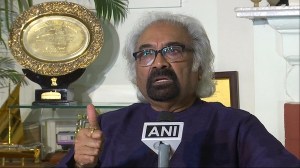- India
- International
IISc, Wipro join hands for driverless car on Indian roads with potholes, cattle
However, scientists and researchers from the Indian Institute of Science (IISc) and IT major Wipro Ltd have joined hands to create a driverless car for Indian conditions with a targeted rollout date of March 2020.
 The car being used for data collection in the project
The car being used for data collection in the project
Building an autonomous or driverless car for Indian roads may seem like an impossibility — given the volume of traffic in cities, the unpredictability of road conditions, the behaviour of people, accident rates and even the presence of stray cattle.
However, scientists and researchers from the Indian Institute of Science (IISc) and IT major Wipro Ltd have joined hands to create a driverless car for Indian conditions with a targeted rollout date of March 2020.
The collaboration is also an effort to take IISc and Wipro to the frontiers of new technology — automation, robotics, machine learning, artificial intelligence and neuro morphic systems.
The nearly one-year collaboration project to build an autonomous car for Indian conditions is an extension of a nearly three-year effort at Wipro to build an autonomous car using data for roads in Europe and the US.
The efforts at Wipro have resulted in “a grounds-up autonomous vehicle” but the real challenge now is to build a car by factoring in the unpredictability of Indian roads, say the IISc scientists and Wipro researchers engaged in developing the car at IISc.

“We are working on some cutting edge algorithms for Indian conditions. Earlier whatever we worked on was user data from Europe and America but we want to do something for India. We cannot use the systems that we built for the other data sets because the conditions here are unique,’’ said Dr Ramachandra Budihal, Wipro’s head for AI, autonomous systems and robotics, who is based on the IISc campus with a team of 18 engineers to build the car.
“It is a greenfield design — everything has been designed from scratch. We are not taking a Toyota or a Honda and retrofitting. We are designing our own electric vehicle and then putting all the systems inside. It is a concept autonomous vehicle,’’ Budihal said.
“In Europe or the US, there is discipline, there is laned traffic. Here, nobody bothers — you have humans, cycles, autos going. If we have an autonomous vehicle in these conditions it has to take care of all these factors, plus the zero infrastructure, the potholes and the fact that everything is random,” said Prof A G Ramakrishnan from the department of electrical engineering at IISc, key investigators in the initiative.
A dozen professors drawn from six IISc departments — aerospace engineering, electrical engineering, electrical communication engineering, electronic systems engineering, electronic design and technology, computer science and automation — are involved in the project, which has nearly 200 participants from IISc and Wipro Ltd.
“IISc will be working on research algorithms which take care of special data, how to process the data and what additional information we can get and what additional sensors we can use. People who have worked in related fields have come together,’’ Ramakrishnan said.
Over the past six months, investigators have been using a car equipped with multiple sensors to collect raw data on aspects of navigating the roads in Bengaluru and have culled out around 100 hours of data, out of nearly 1000 hours collected, to build algorithms and systems for the driverless car.
The plan is to have about 28 sensors on the autonomous car, say the scientists.
“The kind of data the sensors gather and the range it captures is unique for the Indian conditions. The rate of change, the number of events that happen per second is far higher than what is needed any where else. The number of events that take place per second is several and the latency from one event to the next is very small so you have to program. Video, radar, sensors are all being used to gather data,’’ Budihal said.
One of the key challenges in building a driverless car for Indian road conditions is the amount of processing power that will be needed on board the car to process the enormous amount of data coming in from the road environment, say the scientists involved in the project.
“The processing power needed for this data is far in excess of what is seen in more organised environments,’’ said Prof Debasish Ghose of IISc’s aerospace engineering department.
“I was telling Mr Premji (the Wipro Ltd chairman) that last year we felt that even a super computer in the car may fall short of processing power for the amount of data needed for an autonomous vehicle in India,’’ said Budihal.
“I cannot afford to put a high power computing system on an electric vehicle because the power needed to power the computer would be more than the power needed to drive the car and this would not be feasible. That is why we are looking at low power compute designs using a new technology that has come called neuro morphic computing,’’ he said.
Neuro morphic computing technology involves new age computer chips designed to mimic neural systems of the brain which have significantly lower energy requirements than conventional computer chips.
“In IISc, there are professors working on neuro morphic technology and this project is going to be one of the early users of that technology. It will drive the neuro morphic initiative in India,’’ Budihal said.
“The autonomous system design has a lot of spin offs. This is a platform and it has many technology components. This is a certain use case — there will be a certain core technology in terms of algorithms, sensing, computing — all these things are being developed and tested so innovation can happen there. Autonomous vehicles are an excuse to innovate,’’ said Prof K V S Hari from the electrical communication engineering department.
The car project is part of a Wipro IISc Research Innovation Network created recently — Wipro will invest Rs 9.6 crore in collaborative research in cutting edge technology areas like “artificial intelligence, machine learning, computer vision, and human machine interaction, related to autonomous systems and robotics”.
“Wipro’s technology expertise and understanding of domain-specific business challenges coupled with IISc’s distinguished research capabilities will create the right synergies to solve complex industry problems and develop next-gen mobility solutions. This collaboration will enable accelerated development and adoption of autonomous systems and V2X for our customers,” said K R Sanjiv, CTO, Wipro.
More Tech
Apr 24: Latest News
- 01
- 02
- 03
- 04
- 05








































